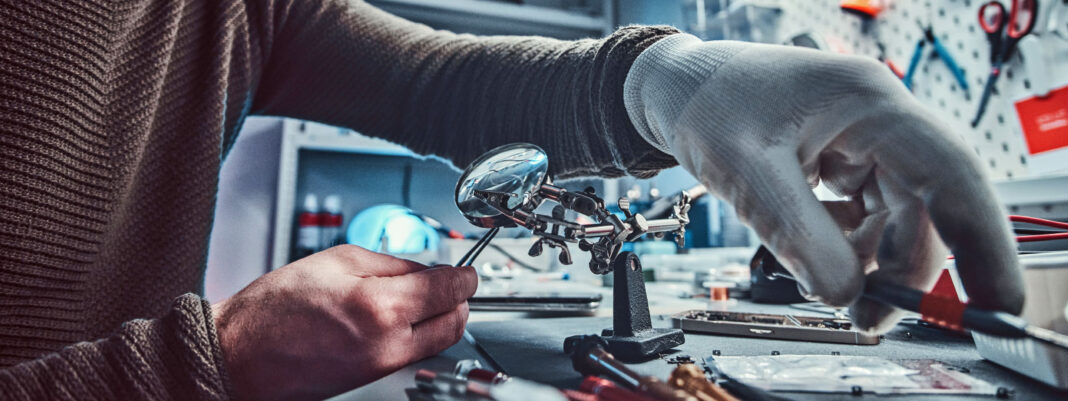Electronics Hand Tools Selection Guide
Working with electronics requires specialized hand tools, and the correct tool for your task always depends on your application. With thousands of options to choose from, selecting tools can be intimidating. This selection guide covers the essential features of the Tweezers, Cutters, Pliers, and Scissors used in electronics, but the final selection depends on knowing your application.
How delicate are your workpieces and materials? What chemicals are involved? How corrosion-resistant do your tools need to be? What are the protocols for preventing electrostatic discharge? How much heat do your tools need to tolerate? With these questions answered, this guide can help you narrow your choices.
Here’s what you need to know:

What to know about Tweezers:
Tweezers are available in a wide variety of shapes and an even wider variety of materials. The correct material for you depends on how delicate your workpieces are, what chemicals are in use, what temperatures you need to work with, and how you will clean your tools.
Brass: Brass non-sparking, anti-magnetic (AM), and is softer than most metals encountered in electronics and will not scratch delicate components.
Carbon Fiber: Carbon fiber is light, ESD-safe, and stands up to chemicals and abrasion. Carbon fiber is often used for replaceable tips (RT) and as a structural reinforcement for plastic materials.
Advanced Ceramic Zirconia: Zirconia-reinforced aluminum offers strength, hardness, and extreme heat resistance. It is ESD-safe, it resists chemicals and abrasion, and solder will not adhere to its surface.
Carbon Steel: Steel with higher carbon content compromises corrosion resistance to improve hardness and strength to help tweezers retain their edge shape.
Stainless Steel: Stainless steel resists corrosion and acid. Some alloys have stronger thermal properties to allow autoclave sterilization, others offer stronger anti-acid and anti-magnetic properties.
Titanium: Titanium is lighter than steel, relatively soft, and non-magnetic. It is bio-compatible and extremely resistant to corrosion, acids, and contamination.

What to know about Cutters
With cutters, everything comes down to the shape of the cutting head. Navigating the wide variety of cutters starts with understanding a few basic head shapes and variations.
Cutters are available in a few basic shapes:
Oval: Oval cutters are the most widely used because the oval head shape provides great cutting capacity—which means it can cut through thicker material than other head shapes.
Tapered: Compared to the oval head, straight jaws that taper to a point compromise some cutting capacity to offer more access where oval cutters cannot reach.
Straight: Straight-head cutters are preferred for horizontal and vertical cuts in hard-to-reach areas.
Pointed: Pointed cutters give you the narrowest possible head shape for access to extremely hard-to-reach areas.
Variations on the basic cutter head shapes include:
Wide vs. Narrow: Wider head designs offer more cutting capacity, whereas narrow head designs allow more access and visibility.
Relieved: A cutting head with a relieved underside offers more access and visibility to hard-to-reach areas
Angled or Oblique: Where most cutters have the head along the same plane as the handles, angled heads improve access and visibility and allow different working angles.

What to know about Pliers
Pliers are used to grip objects firmly and apply more leverage to move or bend that object. The jaws are available in various lengths and gaps with smooth, scored, and serrated grip surfaces. Special-purpose pliers may have additional jaw features to manipulate retaining rings, cut material, or strip wires.
Curved Nose and Long Nose Pliers: These pliers feature jaws that have been shaped to manipulate objects in confined spaces.
Cutting & Crimping Pliers: Often grouped with cutters, these pliers have jaw segments for cutting material and for crimping, or pinching material—convenient for cutting wires and securing connectors to the end.
Slip Joint and Tongue & Groove Pliers: These pliers are designed with jaw positions that change the size of the jaw opening to better grip a wider range of objects.
Locking Pliers: Sometimes called vice grips, or mole grips, locking pliers have a mechanism to hold objects in place without applying clamping force by hand.
Retaining Ring Pliers: These pliers feature pointed, narrow jaws that are shaped to install and remove retaining rings from around conduit, tubing, or similar cylindrical formats.

What to know about Scissors
Much like cutters, electronics scissors are designed for cutting especially small-scale objects and materials that are widely used in the electronics industry. Blades are typically stainless steel, with various shapes and lengths available.
Long-Blade: Useful for longer straight cuts.
Serrated Blade: Ideal for cutting through insulating materials. Some serrated blades are specifically designed for cutting Kevlar/Aramid.
Extra-Fine: High precision scissors for very fine wires and confined spaces
Curved Blade: Curved blades reduce the risk of the tips becoming stuck.
What to know about Data Sheets
Always check the data sheet. That’s it. That’s the secret.
The data sheet will have the final answers as to whether a tool can handle the temperatures, environments, and materials you need to work with.
Whether you’re designing and testing electronics in the lab, working the production line, or troubleshooting in the field, Techni-Pro has the precision hand tools you need for your application—and the data sheets to prove it.



